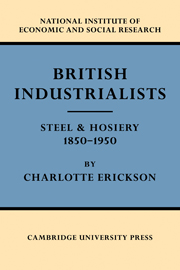Book contents
- Frontmatter
- Contents
- LIST OF TABLES
- Foreword
- Introduction
- I SCOPE OF THE INQUIRY
- II SOCIAL ORIGINS OF THE STEEL MANUFACTURERS
- III CAREERS OF THE STEEL MANUFACTURERS
- IV SOCIAL ORIGINS OF THE NOTTINGHAM HOSIERS
- V CAREERS OF THE HOSIERY MANUFACTURERS
- VI THE INTRODUCTION OF NEW TECHNIQUES IN STEEL-MAKING
- VII HOSIERY INNOVATORS
- VIII THE PUBLIC COMPANY
- Appendix A Selection of firms
- Appendix B List of firms included in steel study
- Appendix C Selection of men for steel study
- Appendix D The hosiery samples
- Appendix E Classification of fathers' occupations
- Appendix F Notes on comparisons with Population Census
- Appendix G Education
- Appendix H Marriages
- Appendix I Careers
- Appendix J Public company tables
- List of Principal Works Cited
- Index of names
- Index of companies
- General index
- PUBLICATIONS OF THE NATIONAL INSTITUTE OF ECONOMIC AND SOCIAL RESEARCH
Appendix F - Notes on comparisons with Population Census
Published online by Cambridge University Press: 07 October 2011
- Frontmatter
- Contents
- LIST OF TABLES
- Foreword
- Introduction
- I SCOPE OF THE INQUIRY
- II SOCIAL ORIGINS OF THE STEEL MANUFACTURERS
- III CAREERS OF THE STEEL MANUFACTURERS
- IV SOCIAL ORIGINS OF THE NOTTINGHAM HOSIERS
- V CAREERS OF THE HOSIERY MANUFACTURERS
- VI THE INTRODUCTION OF NEW TECHNIQUES IN STEEL-MAKING
- VII HOSIERY INNOVATORS
- VIII THE PUBLIC COMPANY
- Appendix A Selection of firms
- Appendix B List of firms included in steel study
- Appendix C Selection of men for steel study
- Appendix D The hosiery samples
- Appendix E Classification of fathers' occupations
- Appendix F Notes on comparisons with Population Census
- Appendix G Education
- Appendix H Marriages
- Appendix I Careers
- Appendix J Public company tables
- List of Principal Works Cited
- Index of names
- Index of companies
- General index
- PUBLICATIONS OF THE NATIONAL INSTITUTE OF ECONOMIC AND SOCIAL RESEARCH
Summary
In 1911 the Census authorities published a table which placed occupation classes in each Census from 1881 to 1911 in parallel columns (1911 Census, vol. x, part I, pp. 540 ff.). Using this table as a guide, Professor Sir A. L. Bowley selected those occupations which could be isolated as non-manual or ‘middle class’ and constructed a series of estimates of the proportions of middle-class and working-class groups in the population at each Census year from 1881 to 1911 (Wages and Income in the United Kingdom since 1860, Cambridge University Press, 1937, Appendix E). Of necessity the series contained certain anomalies. Commercial clerks, because they were separately enumerated in the Census, are in Bowley's middle class while clerks in industry are not. Shop assistants, who have been ranked with skilled workers in the Glass study, are placed in the middle class because in the Census they were not distinguished from dealers. The professional class is a broad one which includes law clerks and medical assistants. The major difficulty, however, is that employers were not returned separately from employees in the various branches of industry before 1911. Bowley met this difficulty by assuming that the proportion of employers to employed found in 1911 had been constant since 1881.
In order to bring an earlier Census into Bowley's scheme, I have tried to select the same occupations as he used from the 1851 Census.
- Type
- Chapter
- Information
- British IndustrialistsSteel and Hosiery 1850–1950, pp. 233 - 235Publisher: Cambridge University PressPrint publication year: 1959



